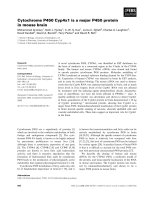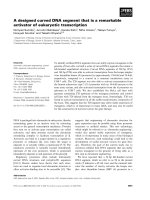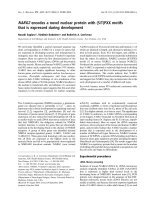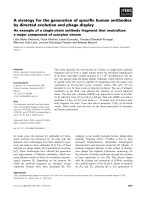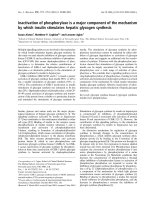topic a company that is facing a major crisis or public relations issue cocoon
Bạn đang xem bản rút gọn của tài liệu. Xem và tải ngay bản đầy đủ của tài liệu tại đây (1.23 MB, 15 trang )
<span class="text_page_counter">Trang 1</span><div class="page_container" data-page="1">
<b>Group AssignmentMGT103</b>
<b>Instructor: Trần Đình ThànhSemester: Summer 2023</b>
<b>PREPARE BY: GROUP 4 </b>
1.Phạm Trọng Nghĩa_______________________ SS1808832.Dương Gia Hân__________________________ SS1807263.Nguyễn Quốc Khánh______________________ SS1810854.Nghiêm Thị Hồng Nhạn___________________ SS1811045.Phạm Nguyễn Thanh Như _________________ SS181310
<b>Topic: A company that is facing a major crisis or public relations issue</b>
</div><span class="text_page_counter">Trang 3</span><div class="page_container" data-page="3">Established in 2013, Cocoon Vietnam is a well-known vegan cosmetics business that isrenowned for its soft and natural products. It is registered with The Vegan Society, a venerableglobal nonprofit education organization that offers advice and information on a range of vegan-related topics. The business TNHH Nature Story Cosmetic-Vietnam is the parent of Cocoon.With all-natural ingredients obtained from different locales, such as Dak Lak coffee, Ben Trecoconut, Tien Giang cocoa butter, and Cao Bang flowers, each Cocoon product embodies theessence of Vietnam. Additionally, they make use of organic components including winter melon,Sachi, pennywort, grapefruit, and more.
The success of Cocoon is due to its compelling tale as well as its unwavering dedication toproducing high-quality products, adhering to the CGMP standards established by the Ministry ofHealth, and being open and honest with its information.
● 100% clear origin of ingredients: All the ingredients used in their products havedocumentation proving their origin (Certificate of Analysis - C.O.A) from distinctivesuppliers in Vietnam and supplementary active ingredients and vitamins from Japan,France, the Netherlands, and South Korea.
● 100% vegan cosmetics: They do not use ingredients of animal origin commonly found incosmetics, such as honey, beeswax, lanolin, sheep's wool fat, sheep placenta, snail slime,shark liver oil, silk, etc.
● 100% never tested on animals: Cocoon's cosmetic formulas are researched and testedthrough in vitro tests or on volunteers (in vivo tests). They do not conduct any tests on
</div><span class="text_page_counter">Trang 4</span><div class="page_container" data-page="4">animals like rabbits, mice, or fertilized chicken eggs.
However, on May 28th, word spread quickly on social media about Cocoon Vietnam's makeupremover containing an unknown object that was possibly a worm. Not long after, on May 29th,the vegan makeup company promptly offered a fix. The makeup removal product with a rosearoma is now limited to distribution centers. To retrieve the merchandise from the shelves forexamination, the business has made contact with these distributors. To keep defective goodsfrom getting to customers, they will be recalled to the factory if any anomalies are discovered.
Internal Environment
Cocoon has fostered a workplace environment centered around innovation, creativity, andexcellence, which has been instrumental in the development of its distinctive products thateffectively cater to customer needs. The company's cosmetic offerings encompass a diverserange of products crafted from natural ingredients. These items not only align with thepreferences of environmentally conscious consumers but also adhere to cruelty-free, vegan, andeco-friendly principles. Additionally, Cocoon boasts a dedicated team comprising talented andseasoned professionals who exhibit a genuine passion for their craft. This contributes to apositive and motivated atmosphere within the organization.
External Environment
<b>Macro environment</b>
</div><span class="text_page_counter">Trang 5</span><div class="page_container" data-page="5">The macro environment of the cosmetic market is influenced by various cultural, social,political, economic, technological, and environmental factors. One significant factor is thecultural and social shift towards environmental protection and a desire for natural products.Consumers are increasingly conscious of the environment and interested in cosmetics that alignwith their values, such as those made from sustainable ingredients and packaged in eco-friendlymaterials.
The political factor in the macro environment refers to government regulations imposed oncosmetic companies. Governments can enact laws and regulations that govern the use of naturalingredients, restrict the use of harmful substances, or even ban materials that contribute toenvironmental pollution. These regulations aim to ensure the safety of cosmetic products andprotect the environment. All cosmetic companies have to strictly adhere to all of theseregulations.
In summary, the macro environment of the cosmetic market is shaped by cultural and socialtrends towards environmental protection and natural products, as well as government regulationsthat govern the ingredients and materials used in cosmetics. By understanding and adapting tothese factors, cosmetic companies can meet consumer demands, comply with regulations, andthrive in the market.
In a large-scale environment, cosmetic ingredient suppliers are conveniently situated,guaranteeing a steady supply for cosmetic companies. This approach effectively lessens relianceon imports and bolsters domestic economic progress. The beauty and cosmetic market is one ofthe most highly competitive markets, it featuring prominent players like L'Oreal, Maybelline,and Shiseido. To thrive amidst this competition, companies must diligently ensure that their
</div><span class="text_page_counter">Trang 6</span><div class="page_container" data-page="6">offerings align with customer demands for environmentally conscious practices and the use ofnatural ingredients. This entails meeting the needs of consumers who seek products thatprioritize environmental protection and possess compositions rooted in nature. By catering tothese preferences, companies can establish a competitive edge and secure their place in themarket.
SWOT analysis
In the skincare and cosmetics field, Cocoon is a well-known and respected name, distinguishedby its remarkable brand reputation and commitment to employing natural ingredients. Cocoonstands out for its dedication to innovation through intensive research and development, whichallows the company to launch ground-breaking goods and use cutting-edge technology to stayhighly competitive with other cosmetic brands.
Cocoon focuses on health-conscious customers by emphasizing the use of safe and naturalskincare products, which impress customers and build strong customer loyalty. Furthermore,Cocoon builds its brand image quite well on the internet through some social media platformssuch as Facebook, Instagram, and TikTok, hence it builds high customer awareness, andcustomers believe that are cared for and listened to by the brand.
Analyzing Cocoon's weaknesses requires discussing its restricted variety of products. Thebrand's current primary concentration on skincare and cosmetics may limit its potential forexpansion and its market reach. Furthermore, Cocoon's geographic reach is restricted to
</div><span class="text_page_counter">Trang 7</span><div class="page_container" data-page="7">Vietnam, which limits its ability to access global markets and a larger clientele. Furthermore,while the brand's dedication to employing sustainable and natural products is commendable, itmay raise production costs, which could affect pricing competitiveness and profitability.
Cocoon has a significant opportunity to tap into the growing demand for natural and organicproducts. With consumers increasingly seeking clean, sustainable, and natural beauty options,Cocoon can capitalize on this trend by expanding its range of offerings in this segment.Diversifying its product portfolio by introducing new lines such as hair care, body care, and oralcare aligned with its natural and safe product philosophy presents a valuable chance for growth.Furthermore, Cocoon has expanded its geographic presence beyond Vietnam, opening doors tonew markets and allowing the brand to increase its customer base internationally. Collaboratingwith other natural and sustainable brands presents another opportunity for Cocoon to enhance itsmarket presence, attract new customers, and strengthen its brand positioning.
Lastly, Cocoon can leverage the growing e-commerce market by emphasizing and expanding itsonline sales channels. This strategy can enable Cocoon to reach a wider audience, improveaccessibility for customers, and tap into the convenience and popularity of online shopping.
Cocoon, despite its numerous strengths and opportunities, also faces several threats that couldimpact its success. Firstly, the beauty and skincare industry is highly competitive, with amultitude of established and emerging brands offering similar products. This intense competition
</div><span class="text_page_counter">Trang 8</span><div class="page_container" data-page="8">poses challenges for Cocoon in maintaining its market share and distinguishing itself fromcompetitors.
Secondly, economic volatility is a significant threat to Cocoon. Fluctuations and downturns inthe economy can result in reduced consumer spending on beauty products, leading to decreaseddemand and sales for Cocoon. This vulnerability to economic changes could potentially hinderthe company's growth and profitability.
Counterfeit products also pose a threat to Cocoon. The presence of counterfeit versions of itsproducts not only damages the brand's reputation but also erodes customer trust and loyalty. Thisrisk highlights the importance of implementing effective measures to detect and prevent thecirculation of counterfeit goods.
Furthermore, Cocoon must navigate the challenge of adapting to evolving regulations andchanging safety standards in different markets. Compliance with these regulations can becomplex and time-consuming, potentially impacting the company's product development andinternational expansion plans.
Lastly, changing consumer preferences can pose a threat to Cocoon. The emergence of newbeauty trends or the increasing demand for sustainable packaging may require the company toadapt its product offerings and marketing strategies to remain relevant and meet evolvingcustomer expectations.
In summary, while Cocoon has many strengths and opportunities, it must also be aware of thethreats it faces in the highly competitive beauty and skincare industry. By proactively addressingthese challenges, Cocoon can position itself for long-term success and continued growth.
Analysis of the Problem
</div><span class="text_page_counter">Trang 9</span><div class="page_container" data-page="9">Cocoon, a reputable cosmetic brand in the Vietnam market, faced a range of opinions fromnetizens after a mistake occurred in one of their products. While some defended the brand,stating that the deep appearance of the rose petals was a result of organic cultivation methodsand the flowers not yet blooming, others criticized and even boycotted the brand's products. In response to the incident, Cocoon provided an explanation of their production process and thematerials used in their products. They highlighted that their roses are cultivated using organicmethods, without the use of pesticides or chemical fertilizers. The petals are carefully manual-gathering before blooming and undergo a closed freeze-drying process to retain their scent andcolor. The manufacturing plant also adheres to good manufacturing practices and meets allproduction conditions according to GMP standards.
However, despite their explanation, the incident left a negative impression on customers andraised concerns about the management of the Cocoon brand. One of the main issues identifiedwas the lack of qualifications and responsibility within the production board. Cocoon'sorganizational structure was found to be lacking a dedicated production and quality controldepartment, which could have prevented such incidents from occurring.
Additionally, the senior management was criticized for not closely monitoring each stage of theproduction process and failing to oversee employee behavior. The company's network-orientedorganizational structure, while offering advantages, posed difficulties in effectively trackingemployee performance. Furthermore, Cocoon had not implemented a robust quality controlsystem to ensure that products met specified standards and were produced under appropriateconditions.
Despite the shortcomings, Cocoon did take swift action by issuing an explanation and recallingthe faulty products. However, some felt that the company's explanation was insufficient toconvince the public. Suggestions were made for Cocoon to provide a video or clip showcasing
</div><span class="text_page_counter">Trang 10</span><div class="page_container" data-page="10">their production process, rather than relying solely on images. Additionally, clearer recall andcompensation documents were recommended to instill greater confidence and satisfaction amongcustomers.
Criticism was also directed towards Cocoon's admission of error, which was seen as vague andlacking accountability. Many key opinion leaders (KOLs) expressed the need for clear feedbackand concrete solutions to address the problem, rather than receiving baseless explanations fromthe brand.
Ultimately, Cocoon managed to mitigate the impact of the incident by taking the time to addressthe issue and remove any negative publicity. However, this approach may have resulted inpotential customers feeling deceived once they learned the truth behind the incident, leading to aloss of trust in the brand.
To ease the concerns of consumers and journalists. Cocoon company has to set accurate andvisionary plans and strategies to undergo this reputation crisis. Below are some of ourrecommendations for Cocoon Company to get over this decline.
1. Terminate all the sin manufacturings and distributions: Stop connecting with the productionand distribution of the products involved in the incident to prevent the further spread of theproblem.
2. Conduct an evaluation: Investigate the root cause of the issue by inspecting the manufacturingprocess, materials used, quality control procedures, inspection steps, agency conflict, and may berelated to financial fraud. This will help identify the source of the problem and prevent it fromhappening again.
</div><span class="text_page_counter">Trang 11</span><div class="page_container" data-page="11">3. Gather customer feedback and quickly prepare plans to fix the problems : Encouragecustomers who have experienced problems with the product to contact the company as soon aspossible to gather detailed information about the issue. The company should be responsive andprovide support to affected customers.
4. Product recall or refund: Consider initiating a product recall and offering a replacement orrefund to affected customers. This will help alleviate customer concerns and show that thecompany takes responsibility for the issue.
5. Upgrade customer connection and social media management: Ensure that the communicationand customer service teams are operated by skilled and experienced staff to handle customerinquiries and provide timely responses. Apologies and updates can be posted on social mediaplatforms to regain customer trust.
6. Long-term prevention measures: All the issues should be implemented measures to preventsimilar incidents from occurring in the future. This may include stricter testing procedures,quality control measures, employee training, and continuous monitoring and inspection. 7. Encourage customer vigilance: Advise customers to inspect products upon receipt anddocument any issues they notice. This will help protect them and provide evidence in case of anyproblems later on. Moreover, this will let Cocoon’s customers know that they were carefullytaken care of by the company.
8. Strengthen retail presence: Establish physical retail locations where customers can purchaseproducts with confidence, knowing they are genuine and safe.
9. KOLs and influencers strongly affect customer insight: Nowadays, customers prefer to havean overview of the products they are interested in. Thus, Cocoon company can invite some
</div>
